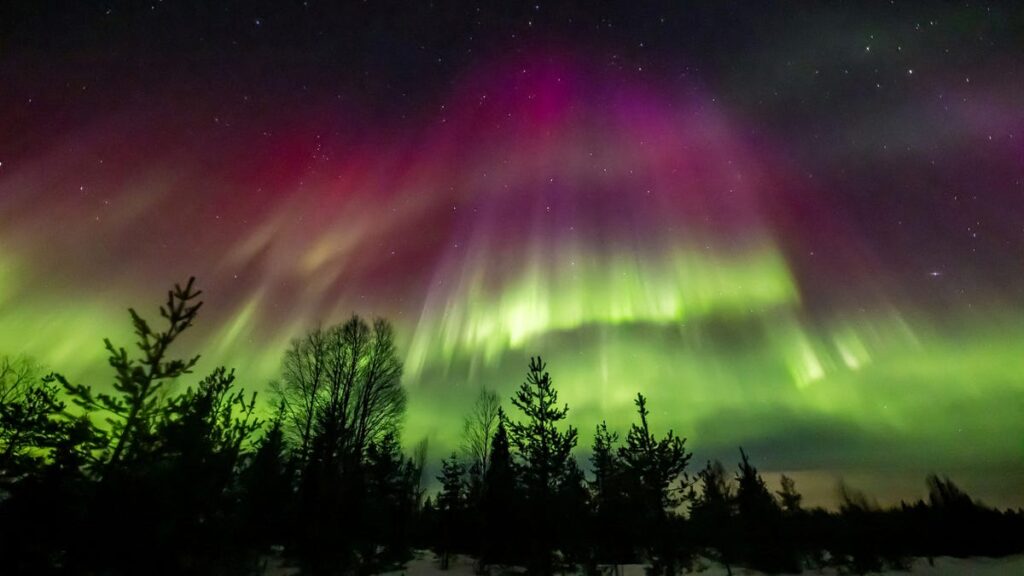As celestial enthusiasts gaze up at the night sky, an exciting opportunity arises tonight as several U.S. states are gearing up for a potential view of the northern lights, or aurora borealis. This stunning light display, more commonly associated with areas in Alaska and Canada, is being made possible by a recent surge in solar activity that has sent powerful charged particles towards Earth, creating a dazzling spectacle in the heavens.
Residents across the northern U.S. are urged to step outside and look for a chance to witness this natural phenomenon, with optimal viewing conditions likely throughout the night. Here’s everything you need to know about where to see the northern lights, the science behind them, and what’s causing their dramatic increase in visibility.
Where Will the Auroras Be Visible?
Typically, auroras are best observed around the magnetic poles of Earth, particularly in regions across Canada, Scandinavia, and Alaska. However, due to a powerful solar storm, expert predictions indicate it is possible to catch a glimpse of the stunning light display much farther south than usual, as far as states like:
- Washington
- Idaho
- Montana
- North Dakota
- Minnesota
- Wisconsin
- Wyoming
- South Dakota
- Iowa
- Michigan
- New York
- Vermont
- New Hampshire
- Maine
- Alabama
- Northern California
The National Oceanic and Atmospheric Administration (NOAA) has reported a Kp index of 5, indicating significant geomagnetic activity. This means that viewers in the aforementioned states may experience enhanced visibility of the auroras compared to routine observations.
Best Time to See the Northern Lights
While excitement builds regarding the northern lights, it’s essential to understand the best times to view this majestic show. Generally, the best time to witness the auroras is within two hours of midnight, assuming the weather conditions are clear and dark.
Experts recommend that if you’re hoping to see the northern lights, it’s wise to escape areas flooded with light pollution. Search for dark spots, perhaps in local or national parks, to maximize your chances of a spectacular view.
Understanding the Science Behind Auroras
The phenomenon of auroras can be attributed to charged particles emitted by the sun, also known as solar wind, interacting with Earth’s magnetic field. As these particles collide with gases in the atmosphere, they produce a beautiful natural light display. Colors can range from green to pink to violet, depending on the type of gas and the altitude of the collisions.
As the sun approaches its solar maximum, which occurs approximately every eleven years, the frequency and intensity of solar storms increase. This current cycle is expected to peak around 2025, suggesting numerous upcoming opportunities for sky gazers to witness the auroras.
The Impact of the Current Solar Storm
Recently, the NOAA’s Space Weather Prediction Center issued a G4 (severe) alert due to a surge of coronal mass ejections (CMEs)—large expulsions of plasma and magnetic fields from the sun’s corona. These have given rise to the enhanced geomagnetic activity that allows for auroras to be visible much further south than normal.
“The strength of the light show will depend on how Earth’s magnetic field interacts with the solar bursts,” said Shawn Dahl at the SWPC.
This latest solar activity can disrupt satellite operations and communications, including GPS functionalities. As solar wind speeds accelerate, viewers are advised to remain alert for updates from NOAA regarding potential auroral displays and safety advisories.
Monitoring Aurora Borealis Activity
For those eager to catch the northern lights tonight or in the upcoming days, monitoring resources are available. NOAA provides an aurora dashboard and a 30-minute aurora forecast which can assist enthusiasts in keeping track of optimal viewing conditions and storm forecasts.
Utilizing apps or websites that track aurora activity, in combination with social media updates from local observatories or astronomy clubs, can enhance your experience and increase the likelihood of witnessing this breathtaking event.
Conclusion: Don’t Miss Out on the Wonders of the Night Sky
Tonight’s forecast holds significant potential for experiencing the northern lights across various U.S. states. With heightened geomagnetic activity and clear, dark skies, skywatchers have an exciting opportunity to witness this natural wonder. Whether you’re a seasoned aurora chaser or a casual observer, tonight may be the perfect night to head outdoors for a glance at the captivating display of lights.

